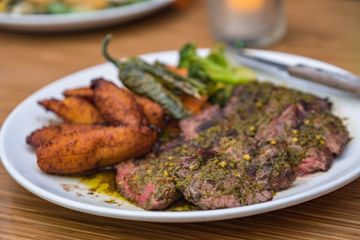Explore why New York Times rated dining spots a top choice
Wiki Article
Why Mexican Food Is Famous: Exploring the Cultural Importance Behind the Dishes
Mexican food sticks out for its vibrant flavors and deep cultural origins. The fusion of native and Spanish impacts produces an unique cooking identification. Each recipe tells a story of celebration, practice, and community. Components like corn and chili peppers play essential functions in forming these narratives. To recognize the full relevance of these cooking methods, one must check out the layers of history and significance that enrich every bite. What lies below the surface of this precious cuisine?The Historic Origins of Mexican Food
Mexican food is frequently celebrated for its vivid tastes and varied active ingredients, its historic origins run deep, reflecting an abundant tapestry of cultural impacts. Originating from ancient Mesoamerican worlds, such as the Aztecs and Mayans, Mexican food developed through centuries of agricultural methods that incorporated neighborhood crops like maize, beans, and chili peppers. The arrival of Spanish colonizers in the 16th century presented new components, including dairy, rice, and pork, which combined with indigenous practices to produce unique cooking combinations. This blend of influences not just formed the recipes however also stood for the social and cultural characteristics of the moment. Over the years, regional variants arised, affected by location, climate, and neighborhood personalizeds. For that reason, Mexican food stands as a representation of its historic trip, symbolizing the resilience and adaptability of its individuals while commemorating their heritage through food.Regional Diversity and Its Effect on Flavors
Regional variety plays a vital function fit the flavors of Mexican food, with each location contributing unique components based upon regional farming and practice. Standard cooking techniques even more boost these tastes, showing the customizeds and histories of individuals. In addition, the differing climates throughout Mexico impact which active ingredients thrive, causing unique regional meals that commemorate the nation's culinary splendor.
One-of-a-kind Components by Area
Mexican cuisine showcases a remarkable range of distinct components that vary substantially across its diverse areas, each adding distinct tastes and cooking strategies. In the seaside locations, fish and shellfish such as shrimp and fish are staples, typically paired with tropical fruits like mango and coconut. The main highlands are understood for their rich range of beans, corn, and squash, forming the basis of numerous standard meals. In the Yucatán Peninsula, achiote and sour oranges convey a distinct taste account, while the north areas prefer beef and wheat-based meals, showing the impact of bordering cultures. Each region's environment and geography shape the local active ingredients, producing a lively tapestry of flavors that highlight Mexico's abundant cooking heritage.
Traditional Food Preparation Methods
The diverse active ingredients discovered throughout Mexico not only shape the dishes however additionally affect the traditional cooking methods utilized in each area. In Oaxaca, the use of a stone mortar and pestle, understood as a "metate," is prevalent for grinding corn and flavors to develop masa and mole. On the other hand, seaside regions frequently utilize grilling and steaming approaches to prepare seafood, showing their access to fresh catch. The highlands might stress slow-cooking techniques, such as barbacoa, where meats are wrapped in maguey leaves and buried in the ground. Each strategy is deeply rooted in the regional culture, showcasing the relevance of custom while boosting the distinctive flavors that identify Mexican food across varied landscapes.Environment's Taste Impact
Although environment varies substantially across Mexico, it plays a crucial role fit the flavors and components that specify the nation's food. Various regions experience distinct climate patterns, affecting the agricultural result and culinary techniques. For example, the dry north is understood for its passionate meats, while the lavish south deals an abundance of exotic vegetables and fruits. Coastal areas gain from fresh seafood, which becomes a staple in their dishes. In addition, the highlands generate distinct herbs and spices that add to regional specialties. This climatic variety not only improves the flavor profiles of Mexican food however additionally mirrors the cultural identity of each area, showcasing the deep link in between the atmosphere and cooking heritage.The Duty of Active Ingredients in Culinary Identification
Important to recognizing cooking identity, the components of a cuisine reveal deep cultural links and historic narratives. In Mexican food, staples such as corn, beans, and chili peppers serve not only as fundamental components yet also as signs of strength and adjustment. Corn, for circumstances, is spiritual, showing its importance to aboriginal cultures and agricultural methods. The range of beans showcases the country's biodiversity, while chili peppers my latest blog post add depth and warm, standing for regional variations and culinary creativity.These active ingredients are intertwined with rituals, customs, and local customizeds, highlighting the importance of place in forming cooking identity. The integration of natural herbs like cilantro and seasonings such as cumin more enhances the flavor account, showing the impact of both colonial backgrounds and native techniques. Jointly, these components develop a vivid tapestry that mirrors the complexities of Mexican society, making its food an effective expression of identity and heritage.
Typical Cooking Strategies and Their Value
Standard food preparation strategies in Mexican cuisine serve as an important link to the nation's heritage, preserving old techniques gave with generations. These strategies not just show local diversity yet additionally enhance the unique tastes that define the cuisine. Recognizing their importance discloses the cultural richness embedded in every recipe.Ancient Methods Protecting Heritage
While contemporary cooking methods have transformed the landscape of Mexican cuisine, old techniques remain an essential link to the country's abundant heritage. Methods such as nixtamalization, the process of dealing with corn with lime to enhance its dietary value, have been crucial fit traditional dishes. Using clay pots and rock mortars, recognized as molcajetes, additionally mirrors the focus on credibility and flavor that has actually been given via generations. These techniques not just maintain the stability of active ingredients however also embody social practices and communal values. By proceeding to use these ancient methods, contemporary Mexican cooks keep a connection to their ancestors, guaranteeing that the cookeries continue to be vibrant and reflective of the country's diverse history.Regional Techniques and Flavors
As varied as its landscapes, Mexican cuisine is identified by a myriad of local methods and tastes that show the unique cultural impacts and regional components of each location. In Oaxaca, using the comal for food preparation tortillas demonstrates a practice gave with generations, while the Yucatán region showcases the slow-cooking method understood as cochinita pibil, emphasizing seasoned pork covered in banana leaves. Coastal areas highlight seafood preparations, with techniques like ceviche mirroring spanish and aboriginal impacts. Each area's distinct flavors, such as the great smoky chipotle from here are the findings Veracruz or the vivid chilies from Puebla, add to an abundant tapestry of tastes - take out and delivery. These standard approaches not only enhance culinary variety yet likewise work as a representation of the resilience and imagination of Mexican societyCelebrations and Festivities: Food as a Cultural Expression
Celebrations and festivities in Mexico are frequently noted by a range of lively recipes that mirror the nation's abundant social heritage. Standard meals, such as tamales during Día de look at more info los Muertos and pozole throughout Self-reliance Day, display cooking techniques and local ingredients, symbolizing community and familial bonds. Food comes to be a medium for storytelling, with each meal lugging historical relevance and regional identifications.In addition to the recipes themselves, the routines surrounding food prep work and intake play an essential function in these events. Family members gather to create sophisticated meals, promoting connections and protecting traditions gave via generations. The common nature of these culinary techniques highlights the relevance of sharing food as an expression of love and unity. Through these festive celebrations, Mexican food transcends simple nutrients, working as a cultural emblem that commemorates heritage, spirituality, and the pleasure of togetherness.
International Impact and Recognition of Mexican Gastronomy
How has Mexican gastronomy obtained such prevalent acclaim around the globe? The answer exists in its vibrant flavors, varied ingredients, and rich social heritage that resonate worldwide. Acknowledged by UNESCO as an Abstract Social Heritage of Mankind, Mexican food showcases an one-of-a-kind blend of spanish and native impacts, making it unique and appealing.Dining establishments specializing in Mexican dishes have actually proliferated internationally, presenting authentic tastes such as mole, tacos, and tamales to varied palates. The popularity of Mexican food has actually likewise been boosted by star cooks and food preparation shows, which highlight its cooking techniques and customs.
Food festivals and cultural events celebrate Mexican gastronomy, additional elevating its status on the globe phase. Therefore, Mexican food transcends boundaries, fostering admiration for its historical value and culinary virtuosity, ensuring its long-lasting influence in the international culinary landscape.
Frequently Asked Questions
What Are the Health Benefits of Standard Mexican Meals?
Standard Mexican recipes use countless health and wellness advantages, consisting of high fiber material from vegetables and vegetables, healthy fats from avocados, and essential nutrients from spices. These active ingredients add to improved food digestion, heart wellness, and general wellness.
Exactly How Can I Recreate Authentic Mexican Dishes at Home?
To recreate genuine Mexican dishes in the house, one should resource fresh ingredients, utilize conventional food preparation strategies, check out local variants, and comply with trusted dishes while welcoming the vibrant flavors and social subtleties integral in Mexican food. (hand crafted margarita)What Duty Do Seasonings Play in Mexican Cooking?
Seasonings are necessary in Mexican food preparation, improving tastes and fragrances. They provide depth and complexity to recipes, showing local variety. Typical seasonings like oregano, cumin, and chili add to the vibrant, vibrant accounts particular of Mexican cuisine.Are There Vegetarian or Vegan Options in Mexican Food?
Yes, Mexican food provides many vegan and vegan options. Dishes such as chiles rellenos, nopales, and numerous bean preparations display the rich tastes and components available, making it easily accessible for those following plant-based diets.Exactly How Has Mexican Food Influenced Other International Foods?
Mexican food has profoundly influenced international foods through the introduction of ingredients like corn, beans, and chili peppers, inspiring fusion meals and boosting flavor accounts in various culinary practices, especially in the USA and Latin America.Mexican food stands out for its dynamic flavors and deep cultural roots. Mexican cuisine is frequently celebrated for its lively tastes and varied components, its historical origins run deep, reflecting a rich tapestry of cultural influences. Regional variety plays a vital role in forming the tastes of Mexican food, with each location contributing one-of-a-kind active ingredients based on regional agriculture and practice. Mexican food showcases an exceptional variety of one-of-a-kind active ingredients that differ considerably across its varied areas, each contributing unique flavors and cooking strategies. As diverse as its landscapes, Mexican cuisine is identified by a myriad of regional strategies and tastes that mirror the one-of-a-kind social influences and local components of each location.
Report this wiki page